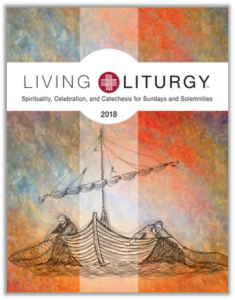Readings for the Solemnity of the Most Holy Trinity, Year B
 About Liturgy
About Liturgy
Homilists often dread preparing the homily for this Sunday’s solemnity because it is so easy to get caught up in trying to explain either a mathematical conundrum or a complex theological mystery. The problem here is not so much the content of the homily but the intent. One cannot “explain” the mystery of the Trinity, not because it is unknowable or difficult. Rather, this mystery is one that we know in our bones because it has been marked upon us from the beginning of our life of faith. The mystery of it is that no matter how much we try to describe what the Trinity is, we could never fully communicate the depth of its meaning because the Trinity is ultimately about relationship. Like any relationship with a loved one, we can only understand it fully by entering into it with our hearts.
You can't “explain” the mystery of the Trinity, not because it is unknowable. The Trinity is ultimately about relationship. Like any relationship with a loved one, we can only understand it fully by entering into it with our hearts. Click To TweetThat was the crux of one of the best homilies I’ve heard on the Trinity. It was memorable because the homilist focused on only one thing: the sign of the cross. What else is this simple gesture but the Trinity expressed in a way that even children could understand?
When we make the sign of the cross on our bodies, we recall that everything we do begins and ends with God. We mark ourselves with a sign that identifies who we are and whose we are. It is a sign that physically encompasses our entire being, reminding us that we are drawn into the life and love of the Trinity, a life-giving and self-sacrificing relationship between Father and Son in the love of the Spirit. The sign of the cross consecrates and gives purpose to anyone and anything we bless with that sign, for the work of the Trinity is to bring blessing to all creation; and all creation is made for being in relationship with the Creator. We first learn the significance of this sign (and thus the meaning of the Trinity) usually from our parents or family and friends who have shared with us their faith. Here, then, we learn that being in a loving relationship with God is not an abstract idea but is a relationship we first encounter through the love of another person for us. By loving others, we embody and deepen our understanding of the meaning of the Trinity.
Being in a loving relationship with God is not an abstract idea. By loving others, we embody and deepen our understanding of the meaning of the Trinity. Click To TweetExcerpt by Diana Macalintal from Living Liturgy: Spirituality, Celebration, and Catechesis for Sundays and Solemnities, Year B, 2018, by Brian Schmisek, Diana Macalintal, and Jay Cormier, published by Liturgical Press. Copyright © 2017, Order of Saint Benedict, Collegeville, Minnesota. All rights reserved. Used with permission..
Image credit: Eye for Ebony, unsplash, CC0.
About Living Liturgy
If you enjoyed this short catechetical article of mine on liturgy, music, or the RCIA, I encourage you to check out the entire Living Liturgy 2018 resource because you will get so much more than just reading from my excerpts. Brian Schmisek and Jay Cormier did a fantastic job of providing a wealth of theological information, pastoral reflections, and practical resources for every Sunday and solemnity of the entire year. Not only do you get all the readings, opening prayers, and Gospel verses for every feast, but you also get scripture exegesis, homily points, psalm response reflections for your psalmists, liturgical preparation questions for all your liturgical ministers and catechists, a lector’s pronunciation guide, sample penitential act tropes, and intercessions, including the presider’s introduction and concluding prayer for those intercessions.
Breaking news!
Living Liturgy 2018 is a finalist for the Association of Catholic Publishers’ Excellence in Publishing Awards in the category of “Resources for Liturgy.”
I have been blessed to be part of this project that continues the good work begun by Sr. Joyce Ann and Sr. Kathleen and Liturgical Press, and I pray that our team’s contribution through Living Liturgy will help you every week of the new liturgical year.



Leave a Reply